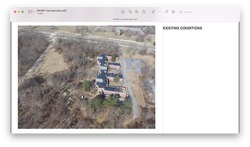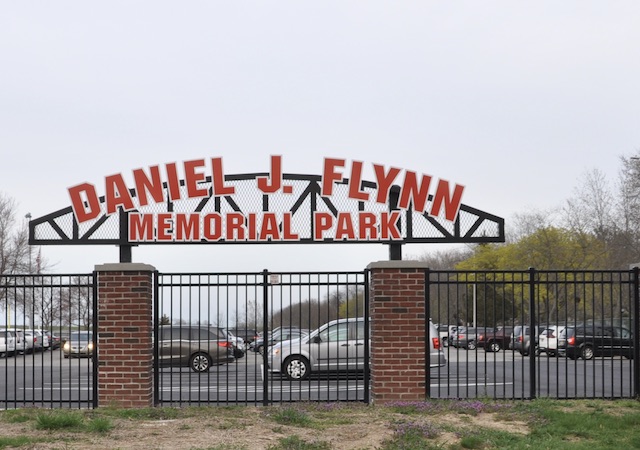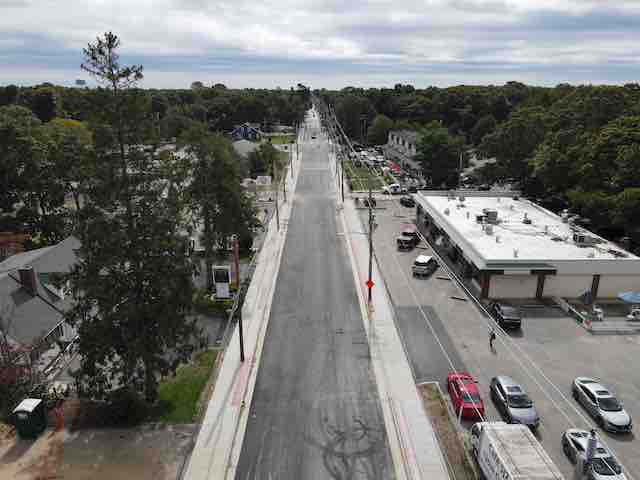News Of Long Ago - Smithtown Has A History Of Snow
 Wednesday, February 26, 2014 at 5:39PM
Wednesday, February 26, 2014 at 5:39PM News of Long Ago by Bradley Harris, Smithtown Historian
Thanks to Cathy Ball and the Smithtown Library for the photos. Click on the photos to enlarge.
(I have been writing about life in Smithtown in the 1930’s, 40’s, and 50’s. This article takes a look at winters of the past, how they were different from those of today, and how people in Smithtown coped with and enjoyed winter weather. The content of this article comes from a discussion with George Arns, Lee Corbani, Tom Hancock, Gus Metzger, Carol Palmer, Charlie Richardson, Pete Vitale, and Sal Vitale. A complete recording of this discussion is available through the Long Island Room in the Smithtown Library, Voices of Smithtown, 1-4-08.)
“Of winters past….”
 The intersection of Bellemeade Avenue and Main Street showing the snow piled up by the 1934 snowstorm that paralyzed the little town of Smithtown Branch. The first building on the left is Valentine’s Liquor Store on the site now occupied by Cress Florist. East of Bellemeade Avenue is the Smithtown Branch Post Office, the Royal Arcanum Hall, and Huntting’s General Store. (Photograph courtesy of the L.I. Room, Smithtown Library.)At a time when global warming seems to be accelerating and causing a dramatic change in our weather patterns, our winters are getting decidedly warmer. We don’t get the snowfall that we used to experience not so long ago, and now we sometimes go through the winter without much snow at all.
The intersection of Bellemeade Avenue and Main Street showing the snow piled up by the 1934 snowstorm that paralyzed the little town of Smithtown Branch. The first building on the left is Valentine’s Liquor Store on the site now occupied by Cress Florist. East of Bellemeade Avenue is the Smithtown Branch Post Office, the Royal Arcanum Hall, and Huntting’s General Store. (Photograph courtesy of the L.I. Room, Smithtown Library.)At a time when global warming seems to be accelerating and causing a dramatic change in our weather patterns, our winters are getting decidedly warmer. We don’t get the snowfall that we used to experience not so long ago, and now we sometimes go through the winter without much snow at all.
George Arns remembers that in the 1930’s, snow “came early and stayed all winter long. We always had snow in October, and by Thanksgiving, we would have two to three feet of snow on the ground. Real hard storms and blizzards would hit and dump lots of snow. There was a storm in 1934 and another in 1936. I believe the storm in 1936 dumped four feet of snow in Smithtown.” That was the storm when George, his brothers, and neighbors, dug a path through the drifts down Hauppauge Road from the Arns’ Garage, on the corner of Maple Avenue and Route 111, to the Kimbrig’s Store in Hauppauge. “That was the nearest store, and in those days, you kept very little fresh food on hand. We had iceboxes, but after three days, everybody was running out of food. The roads were absolutely stopped up with snow. Nothing moved. It took almost two weeks before they actually got a vehicle through the drifts of snow.”
At that time, the highway department didn’t have any equipment that could handle the deep drifts of snow. “The highway department had tow plows. They had an old Adams 77 grader and they towed a wooden V-shaped plow behind it. The grader had a ‘budagas’ engine and eight large truck tires. It used to get stuck even after we added chains. They could only keep the main roads open. The side streets were never plowed. Route 111, a State road, was absolutely locked in. Jericho Turnpike was kept open, but even between towns, it was tough to keep the highway open.”
After the 1934 storm, the highway department purchased a big oiler that was used to spray oil on the roads and to plow town roadways. This Walters truck had four-wheel positive drive, and when it was carrying weight, it would go in any snow. They mounted a huge V-shaped push plow on the front of this truck and used it to clear the roadways in town.
 Captions for the photographs accompanying this article: Snow drifts surround the Bank of Smithtown following the 1934 snowstorm that deposited several feet of snow on Main Street in Smithtown Branch. (Photograph courtesy of the L.I. Room, Smithtown Library.) “Snow was piled up in the middle of Main Street, sometimes fifteen feet high, all the way down Main Street. After the storms were over, that’s when they came in to clean out the snow.” The highway department had a Haiss loader, with big paddles, and it broke up the snow, pushed the snow into buckets, and lifted the buckets on a chain driven conveyor to dump the snow into the bed of a waiting truck. Then they’d take the snow and dump it into the fields somewhere. This is the way they got rid of the big windrow of snow in the middle of town. They used this equipment until the 1950’s when my father, Bill Arns, built a portable conveyor for the highway department that was more mobile and easier to use than the earlier conveyor.”
Captions for the photographs accompanying this article: Snow drifts surround the Bank of Smithtown following the 1934 snowstorm that deposited several feet of snow on Main Street in Smithtown Branch. (Photograph courtesy of the L.I. Room, Smithtown Library.) “Snow was piled up in the middle of Main Street, sometimes fifteen feet high, all the way down Main Street. After the storms were over, that’s when they came in to clean out the snow.” The highway department had a Haiss loader, with big paddles, and it broke up the snow, pushed the snow into buckets, and lifted the buckets on a chain driven conveyor to dump the snow into the bed of a waiting truck. Then they’d take the snow and dump it into the fields somewhere. This is the way they got rid of the big windrow of snow in the middle of town. They used this equipment until the 1950’s when my father, Bill Arns, built a portable conveyor for the highway department that was more mobile and easier to use than the earlier conveyor.”
By the 1950’s, the highway department could muster enough men and equipment to clear the roads in any heavy snowfall. They kept up with the snowfall and kept the roads open. According to Charlie Richardson, it didn’t make any difference to the kids anyway. “There were no snow days. We went to school. There was no closing school down. The buses ran, people knew how to drive in snow, and we didn’t have the volume of traffic we have today. Most of the kids walked to school and they just slogged through the snow.”
Tom Hancock remembers shoveling snow for the highway department. He earned 75 cents an hour. The highway department was right behind Town Hall, and when the town experienced a heavy snowfall, the Highway Superintendent would recruit high school boys to clear snow off the sidewalks in town. Tom worked with a crew clearing sidewalks on New York Avenue. “One of the older Fiedler boys and Billy Mason would be in charge, and they would always put us to work and then disappear. They would come back when the sidewalks were done. That went on for a number of years. We used to do the sidewalks on Main Street and Avenues off Main Street.” Pete Vitale remembers cutting school to shovel snow. “So where did they put you? Right in front of the school. Everybody had their backs facing Mr. Floody’s office because they didn’t want to get caught playing hooky.” For some reason, nobody ever got caught.
 The intersection of Bellemeade Avenue and Main Street showing the snow piled up by the 1934 snowstorm that paralyzed the little town of Smithtown Branch. The first building on the left is Valentine’s Liquor Store on the site now occupied by Cress Florist. East of Bellemeade Avenue is the Smithtown Branch Post Office, the Royal Arcanum Hall, and Huntting’s General Store. (Photograph courtesy of the L.I. Room, Smithtown Library.)After the first couple of snow storms, the roads in town would have a hard packed base of snow covering them. This made the hills in town terrific slopes for sledding. In the 50’s, the highway department never used salt on the roads. After a snow storm and roads had been cleared, the town would come along with sand trucks, and two men standing on the back of the truck would shovel sand on the road on the slopes of hills and at intersections where cars might slide on the snow. But typically they only put sand on the slopes going up hills and this left the downhill slopes free of sand. This meant that kids could sled down some of these long hills.
The intersection of Bellemeade Avenue and Main Street showing the snow piled up by the 1934 snowstorm that paralyzed the little town of Smithtown Branch. The first building on the left is Valentine’s Liquor Store on the site now occupied by Cress Florist. East of Bellemeade Avenue is the Smithtown Branch Post Office, the Royal Arcanum Hall, and Huntting’s General Store. (Photograph courtesy of the L.I. Room, Smithtown Library.)After the first couple of snow storms, the roads in town would have a hard packed base of snow covering them. This made the hills in town terrific slopes for sledding. In the 50’s, the highway department never used salt on the roads. After a snow storm and roads had been cleared, the town would come along with sand trucks, and two men standing on the back of the truck would shovel sand on the road on the slopes of hills and at intersections where cars might slide on the snow. But typically they only put sand on the slopes going up hills and this left the downhill slopes free of sand. This meant that kids could sled down some of these long hills.
Charlie Richardson remembers sleigh-riding down the long hill toward the statue of the Bull. “They used to sand the south side of the road, but you could sleigh-ride all the way downhill on the north side. And over by Sunken Meadow State Park, we used to sleigh-ride down that hill on 25A.” Pete Vitale remembered that another favorite hill was the hill on Blydenburgh Road near the Hauppauge dump. “We used to ride all the way down to Townline Road. That was a fast ride. We used to hit a patch of bare road, where the sun melted the snow, and sparks would be flying – it looked like somebody was welding.” It cleaned the rust off the sled’s runners.
Golden Hill was a favorite run, but kids had to keep an eye open for cars. Gus Metzger used to go sledding on Golden Hill. He was one of those kids who would come off that hill, down Bellmeade, and shoot across Main Street. Fortunately no one ever was hit by a car because as Charlie Richardson pointed out: “People didn’t drive fast in snow, and if snow was deep, they put chains on. We used to carry strap-on chains and if conditions became bad enough, we’d just put chains on.” The snow packed down and became an excellent sledding surface. There were a couple of smaller hills in everyone’s back yard. There were hills near Micciches, behind Frank Friede’s, off Cherry Lane, and a favorite spot opposite the Elks Lodge. When it snowed, kids would be everywhere on their Flexible Flyers.
Tom Hancock swears he had the fastest sled in town – a Yankee Clipper. It was light, Tom was light, he always took a running start, belly-whopped, and would go flying down the hills. There weren’t many kids that could beat him. Sometimes Tom would really be flying, especially when he latched onto the back of a car’s bumper and was towed behind a car. Motor Parkway, down by Lake Ronkonkoma, was a favorite place to ride the hills. Tom remembers starting on the hill near the Hyatt Inn and being pulled by a car to the first turn in the road, and then “you were supposed to let go and you’d fly down the road to the bottom of the hill, where the car would be waiting to pull you back up again.” Cars were used to pull sleds and kids on skis. “Sometimes kids on skis would be afraid to let go or held on too long , and you really had to be careful, because if you got going too fast, you would go careening off into the woods, and that kind of ruined the day because it took us a while to find them in the woods and snow.”
Gus Metzger used to tow kids on skates. His favorite trick was to take his Model A Ford down to Miller’s Pond, and when the ice was thick enough, he would drive out on the ice. With a rope he had dragging behind the car, he would pull 17 or 18 skaters around the pond, and then spin out, “cracking the whip” of kids. “Then they’d come off the pond and sometimes smash into a telephone pole.” Sometimes it was his car that smashed into a telephone pole and then “we’d go up to Schuberts, and we’d bang out the fender. That was in the 1940’s.”
Miller’s Pond was a great place to hang out and skate during the winter and people used to gather there whenever the pond froze over. George Arns recalls that a good many people came down to skate and on some occasions there would be 150-200 people skating on the pond. At night, bonfires would be lighted around the edges of the pond, just off the ice, so people could see to skate. The fires were also a great place to roast potatoes or marshmallows. Gus Metzger used to “steal two potatoes at home, bring them to the pond, roast them in the ashes until they got black, and then eat them. They were delicious.” The fires also gave you a place to warm up, especially if you fell in, and Gus Metzger was always falling in the pond. “You always fell in the pond, I fell in two or three times a day. I’d go home, my mother would beat me up because my clothes were all full of mud, frozen and wet – I’d change clothes and go back to the pond. An hour later, I’d be back in the weeds somewhere, I’d fall in again, and go back home and change again.” Tom Hancock remembers following channels through the reeds that led far into the surrounding woods where he hid from his friends, and that’s where you could fall through the ice. But it wasn’t very deep, just up to your knees, so you didn’t get into trouble. Some kids did get into trouble in deeper parts of the pond. George Arns recalled that “one of the Ruppert twins who lived on Maple Avenue fell through the ice and drowned.” Gus Metzger recalled that several other boys also drowned in the pond. There were several spots where you could get in trouble, by the dams where the water was always flowing, and spots where springs kept bubbling up and the ice was thin. The Millers would fence off the pond after a tragedy, but before long the fence would be broken down, and skaters would be back on the pond.
After a while, the town used to send men down to the pond to test the ice and make sure the ice was thick enough for people to skate on it. Later on, the town put up signs that said: “Skate At Your Own Risk,” but that was in the early 1950’s. George remembers skating on thin ice and seeing it give way beneath his skates. “It was just like rubber and you had to keep moving. If you stopped, you fell in.” That’s what happened to Gus – “I couldn’t skate worth a darn, I couldn’t go as fast as these guys,” and in the pond he went. Fortunately Gus lived on Maple Avenue, not far from the pond, so he’d go home, “get his little beating, change clothes, and be back down there again.”
Tom Hancock remembers playing hockey on Miller’s Pond. “The games were organized by older boys like Peter Dounias and Larry Hendrickson. They made up the teams and refereed.” Tom remembered that in the cold weather he bundled up and wore layers of clothing. As he played and worked up a sweat, he would peel off layers of clothing, until by mid-day, he would be stripped down to his undershirt, sweating profusely, and dying of thirst. The boys would call time out to skate over to a spot in the ice where a spring was located, and then slack their thirst with a quick drink of pond water. Then as the afternoon wore on, the layers of clothing would be put back on to cope with the evening chill. When Tom first started playing hockey, he didn’t have skates, and he used to play goalie in his street shoes. Eventually he bought a pair of shoe skates and then he learned to skate with a goalie stick for support. He became a pretty good hockey player and moved out of the goal to play on a hockey line. But he discovered that he wasn’t a very good skater when he didn’t have a hockey stick in his hands. Whenever he tried to skate with his friends in the evening, he couldn’t get his feet under his body, and he was constantly falling. But that was ok, because Tom discovered that his two girlfriends were always there to prop him up, and it was much more fun to skate with two pretty ladies by your side.
There were other places where people skated in the winter, on Judge’s Pond, on the pond by the Bull, and sometimes when Bill Rodgers let you, on the Mill Pond at the Wyandanch Club. But Miller’s Pond was the place where everybody in town came to skate. It had the best ice and smoothest surface and that was because the Smithtown Fire Department would bring their fire trucks down to the pond and spray water on the ice. Sometimes the firemen would leave the trucks there so they could light the surface of the pond at night for the skaters. And on cold winter nights, Carol Palmer remembered that the fire department would even serve hot chocolate to the crowd that skated on Miller’s Pond. The simple assistance that the firemen gave spontaneously to their friends and neighbors so that they might enjoy skating on the ice of Miller’s Pond says a lot about what winters were like in Smithtown Branch not so long ago.






Reader Comments (2)
Hooray Brad Harris! Great putting together of this event! Hooray for history!
Kids enjoy the most skiing in winter season . It is the best time to teach them skiing and other snow sports. These sports actually help your child in many ways. You can take them to skiing camps at location ski alpe d'huez where they can easily learn skiing with other kids as well.